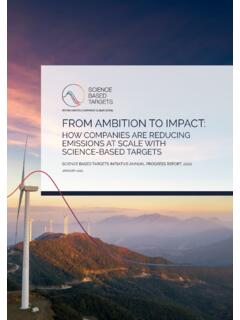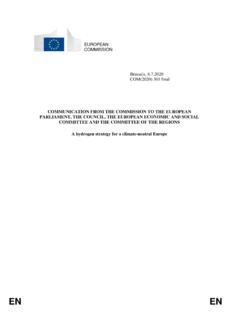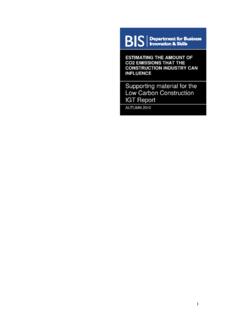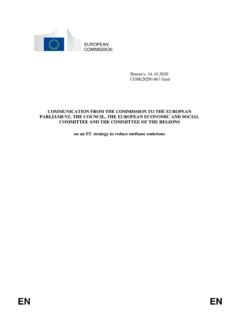Transcription of CO2 Emissions Profile of the U.S. Cement Industry
1 CO2 Emissions Profile of the Cement Industry Lisa J. Hanle Environmental Protection Agency, 1200 Pennsylvania Ave, NW. Washington DC 20460 Kamala R. Jayaraman and Joshua S. Smith ICF Consulting, 9300 Lee Highway, Fairfax, VA 22031 ABSTRACT Global carbon dioxide (CO2) Emissions from Cement production were approximately 829 million metric tons of CO2 (MMTCO2) in 20001, about of global CO2 Emissions from fossil fuel combustion and Cement production. The United States is the world s third largest Cement producer, with production occurring in 37 states. Cement production is not only a source of combustion-related CO2 Emissions , but it is also one of the largest sources of industrial process-related Emissions in the United States. Between 1990 and 2001, process-related Emissions increased 24%, from TgCO2 to TgCO22.
2 National estimates of process-related Emissions are calculated based on methodologies developed by the Intergovernmental Panel on Climate Change (IPCC)3,4. Combustion-related Emissions from the Cement Industry were estimated at approximately 36 TgCO2 accounting for approximately percent of combustion-related Emissions in the industrial sector. in 2001,5 This paper explores, on a more disaggregated level, the geographic location of CO2 Emissions sources from the Cement Industry . This paper begins by providing a brief overview of the Cement Industry , including national level estimates of energy use and carbon Emissions . The focus of the paper is on the development of a Cement Industry Profile for the United States. Based on facility-level capacity statistics, a bottom-up analysis was undertaken to identify sources of CO2 Emissions in the Cement Industry in order to gain a better understanding of the geographic scope and concentration of this Emissions source.
3 INTRODUCTION Globally, over 150 countries produce Cement and/or clinker, the primary input to Cement . In 2001, the United States was the world s third largest producer of Cement (90 million metric tons (MMt)), behind China (661 MMt) and India (100 MMt).6 The United States imported about 25 MMt of Cement in 2001, primarily from Canada (20%), Thailand (16%) and China (13%). Less than 1% of domestic production was exported. The primary destinations for export were Canada (82%) and Mexico (6%). Cement is often considered a key Industry for a number of reasons. To begin with, Cement is an essential input into the production of concrete, a primary building material for the construction Industry . Due to the importance of Cement for various construction-related activities such as highways, residential and commercial buildings, tunnels and dams, production trends tend to reflect general economic activity.
4 Furthermore, because of the large demand for Cement , the relatively high costs associated with transport of the high-density product, and the wide geographic distribution of limestone, the principal raw material used to produce Cement , Cement is produced across the United States. 2 Cement production also is a key source of CO2 Emissions , due in part to the significant reliance on coal and petroleum coke to fuel the kilns for clinker production. Globally, CO2 Emissions from Cement production were estimated at 829 MMTCO2 in 20007, approximately of global CO2 Emissions from fossil fuel combustion and Cement production. In addition to combustion-related Emissions , Cement production also is a source of process-related Emissions resulting from the release of CO2 during the calcination of limestone. Annually, the United States submits a national inventory of GHG Emissions to the United Nations Framework Convention on Climate Change (hereafter referred to as the Inventory).
5 Emission estimates included in the Inventory are based on methodologies developed by the IPCC, as well as some country-specific methodologies consistent with the IPCC. The Inventory estimates process-related Emissions from Cement production to be TgCO2 in 20018. Due to the nature of the IPCC Guidelines, as well as the way industrial sector Emissions are estimated in the United States, combustion-related Emissions resulting from the Cement Industry are not as well characterized. While combustion-related Emissions from Cement production are incorporated into the Inventory, they are aggregated and presented in the estimate of CO2 Emissions from fossil fuel combustion. This paper highlights the results of research to explore more in-depth, process and combustion-related Emissions from the Cement Industry as a whole and on a more disaggregated level.
6 Developing such a Profile of the Cement Industry is important for several reasons, including: Development of time-series estimates for combustion-related Emissions Comparison of bottom-up analyses with publicly available national estimates as a useful quality assurance and quality control activity Identifying the structure of the Industry . For example, are there relatively few large companies or facilities, or is the Industry dispersed across the country? Are companies primarily or international? Identifying the array of technologies and processes utilized in various parts of the country, allowing typical practice to be identified and, subsequently, opportunities for achieving Emissions reductions Identification of local resources available that may be consumed as alternative fuels in existing facilities.
7 This paper begins by briefly discussing the Cement production process, the sources of energy consumed in the process, and the resulting CO2 Emissions . The focus of the paper is on the development of a Cement Industry Profile for the United States. Based on facility-level capacity statistics, a bottom-up analysis was undertaken to identify sources of CO2 Emissions in the Industry in order to gain a better understanding of the geographic scope and concentration of this Emissions source. Cement PRODUCTION PROCESS Cement s raw materials, calcium oxide and other minerals (such as silicon, aluminum and iron oxides) are taken from the earth through mining and quarrying. These minerals are crushed into a more manageable aggregate and transported for further processing. The manufacture of clinker and subsequently Cement entails three major functions: kiln feed preparation, clinker production, and finish grinding9.
8 1) Kiln Feed Preparation. Using dry or wet processes, mineral inputs are reduced to ground meal (powders or slurries, respectively) before they are sent to kilns for clinker production. The raw materials are first crushed to a maximum of 6 inches in diameter and then crushed a second time to a maximum of about 3 inches in diameter. In the dry process, the crushed material is fed into the kiln. In the wet process, the ground materials are first mixed with water to form a slurry before being fed into the kiln. The use of the dry process for Cement production has increased significantly in the last couple of decades (Figure 1), partially due to the lower fuel requirements for the dry process (discussed further below). In 1975, dry kilns comprised 38% of all kilns, whereas in 2001, dry kilns accounted for approximately 70% of all kilns10.
9 This transition from the wet to the dry process coincided with a decrease in the total number of kilns in operation. Over the same time period production increased from 75 MMt in 1975 to 90 MMt in 200111 (Figure 2). The decrease in total number of kilns in operation (wet, dry and both), along with an increase in total production, illustrates that the average capacity of kilns has increased over time. Figure 1. Number of Kilns by Process020406080100120197519771979198119 83198519871989199119931995199719992001 KilnsWetDryBothSource: USGS Mineral Surveys (data from Surveys in 1975-2002)Figure 2. Total Cement Production: 1975-20024050607080901001975197719791981 1983198519871989199119931995199719992001 Million Metric TonsSource:USGS. Various Years (1975-2002). Minerals Yearbook , Vol.
10 1. Metals and Minerals. Geological Survey. Department of the Interior. 3 42) Clinker Production. Clinker is produced in a kiln by pyro-processing the ground materials from Step 1 at approximately1500OC. Kilns can be fueled by a range of energy sources, from fossil fuels to alternative fuels such as shredded tires and waste oils. Coal has been the primary source of fuel in the United States since the 1970s12. This step consumes over 90 percent of the Industry s total energy. 3) Finish Grinding. After the clinker is cooled, the clinker nodules are ground into a super-fine powder in a horizontal tube containing steel balls. During the finish grinding process, the type of Cement is determined based upon the type and quantity of additives added. Cooled clinker can be mixed with a small quantity of gypsum to produce Portland Cement or can be mixed with a greater quantity of lime to produce masonry Cement .
















